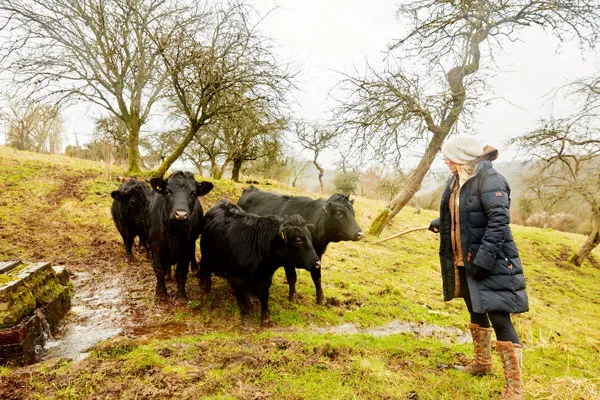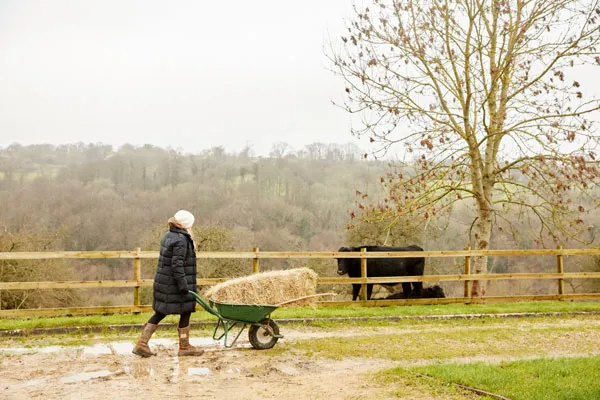Thinking back, there was a word of warning about Dexter cattle being a bit nuts. A friend-of-a-friend had bought some but, no sooner had they arrived, they were through the fence and away. Not such a disaster but for the fact that some remained at large for three weeks. And at least one needed to be taken out with a rifle in the end.
However, having stood next to Holsteins and Fresians (the standard black and white milkers), I wasn’t nearly ready enough to take on animals of such massive size. So with the grass in the orchard high enough to lose livestock, the miniature Dexters arrived, charging around the perimeter and immediately getting stuck into the browse. Now, some months on, they’re easily the lowest maintenance animals one could wish for: eyeball, ensure water trough is full and move on with the day. Compare that to sheep, which require quite the ugliest fencing; are continually seeking out more imaginative ways to die; and ultimately leave you with a bowling green that is great for, well, not much wildlife.

The cattle are still out now as I write, in the bleak midwinter, having seen off the worst of the thick grasses. But they are on the spectrum of bonkers. One minute they will enjoy having their big heads held and stroked. The next, they’re upending the cameraman’s tripod, flicking out their back legs around head height and demonstrating the spatial awareness of children by coming to greet me at 30mph and not putting the brakes on terribly hard.
When the apples were ready in the golden days of autumn, the tarpaulins were laid out, the crates ready and my family stood expectantly waiting for the harvesting to begin. The first shake of the tree, the first bright apple landed, hands in the air and a cheer instantly interrupted by a big furry head entering the frame to snaffle it in one crunch. “Yeyyyyyyyy…oh.” They were penned for the rest of the afternoon. Not least because some cattle can get acidosis if they eat lots of apples: too many fermentable carbohydrates ingested quickly causes the pH in the rumen to drop and results in abdominal pain, rapid heart beating, fast breathing, diarrhoea and lethargy. Others, the vet told me, don’t get acidosis at all and just get incredibly fat. Either way, I didn’t want four heavy beasts contending for every apple with my two-stone children.
Little cattle, big characters
I wonder about their temperament. Without a shred of evidence to back this up, I liken it to animals in the wild. For my first ever wildlife series, in 2005, I was in Australia filming its most deadly snakes, spiders and jellyfish. As a coastal taipan – whose venom is rated as the third most toxic in the world – was draped around my neck ready for a take, I was placated by how incredibly calm it was. With the knowledge that it could overcome any threat in one bite, why waste energy on aggression? Compare that to non-venomous pythons, for example, which can be pretty antsy.

It’s broadly observable in dog breeds too: the larger and more assured the dog, the less aggressive, while smaller breeds that have an issue with their ego can be more vocal and battle-hardy. (Don’t write in, I’m not that interested in dog breeds.) Perhaps this miniature native breed of cattle, while being hardy and hefted, has a point to prove from its diminutive position looking up at everyone. But I like them, just as most farmers who keep both cattle and sheep prefer their cattle.
So what next? Back to the master plan: more wildlife please. Beginning with wildflowers to bring in the invertebrates to bring in the rest. On the sunny day (you remember the one?) of last summer, I was over at Roger’s place across the valley with the lovely folks from Cotswold AONB and their shiny new seed harvester collecting the good stuff. And now that the cattle have done a number on the grass exposing the earth in places, we can broadcast the seed, ready for a frost to kick-off germination. Considering the inevitable fate of the daffodils and crocuses that have jumped the gun a bit, the frost is still yet to happen and there’s not much winter left. But I remain hopeful and, come May time, the cattle will have to Keep Off the Grass (in places) for the summer while I watch the ground hopefully. I’m told that yellow rattle is quite magical, taking off and making room for more wildflowers as the years go by.

Moral dilemmas of meat
The dilemma for me is the cost of doing all this on land that I can never own. So little land comes up for sale publicly, I wonder if I’ll ever get to call a patch my own and fill it with stories. (If you know of 50 or so acres to sell in the Stroud Valleys, please drop me a line). The other dilemma is the fate of the Clan. Last time, I wrote that we’d likely keep the cattle as pets. But to my surprise, nobody has named them – they remain the Moo-Tang Clan after the New York hip hop artists, comprising Moo-God, Ol’ Dirty Bovine – and then we ran out of ideas. Could I send them to slaughter? Yes. But with caveats.
It’s a list of caveats that sits with me every day, and one that doesn’t make a soundbiting piece to camera. So every time meat is offered to me on Countryfile, I’m left rather impotently saying, “I’m veggie” for TV brevity. But at every menu and meal of every day, this is what I think about:
1) Is it an animal I could kill myself?
Not just in hungry desperation, but could I end and accept the quiet sacrifice of life? For fish, yes I could. Indeed, for Countryfile recently, we filmed at a salmon farm in Scotland where I spent time off-camera at the ‘killing table’ (I appreciate the name), watching in detail the moment of death and swiftly afterwards cutting the main artery so that the final few beats of the heart pump out the last of the blood. If I was squeamish or sad about it, or if I wanted somebody else to do it, I didn’t deserve to eat salmon.
But the pigs I’ve observed on farms have traits of intelligence on a par with dogs. Lambs are uncomfortably young when they go to slaughter and it’s noted at the market shed that the ewes will mourn for several nights.
Am I okay with that? No. But ‘mutton’, which is two years old, I could eat.
2) Did this animal have a good life?
This sounds obvious as well as subjective. Countryfile covers stories about factory-farming of broiler chickens very well, for example. Not easy to get a handle on with food labelling: caged animals could be labelled ‘traditional’ or ‘farm fresh’. So without knowing, I won’t eat it.
3) Did this animal have a good death?
This is about suffering and stress. Considered deer culling and a bullet in the wild to me amounts to a good death. But there are good and not so good abattoirs. And abattoirs that are many road miles away from the farm. To my knowledge, there are no abattoirs open to the public or to school trips and I think it’s a shame. It’s the last connection to our food that’s missing amid the resurgence of interest in food provenance. In the BBC’s Kill It, Cook It, Eat It programme years ago, it was the inclusion of this moment that swung vegetarians to the meat side, and carnivores to the leafy side as people consumed their own personal ethics.
The brilliant Dr Temple Grandin has spent her career considering the journey to the end for cattle, helped, she says, by her autism. The moment of death is key. It should be quiet, quick and as stress-free as humanly possible.
These concerns don’t make for a pithy piece to camera, I’m sure you’ll agree.
